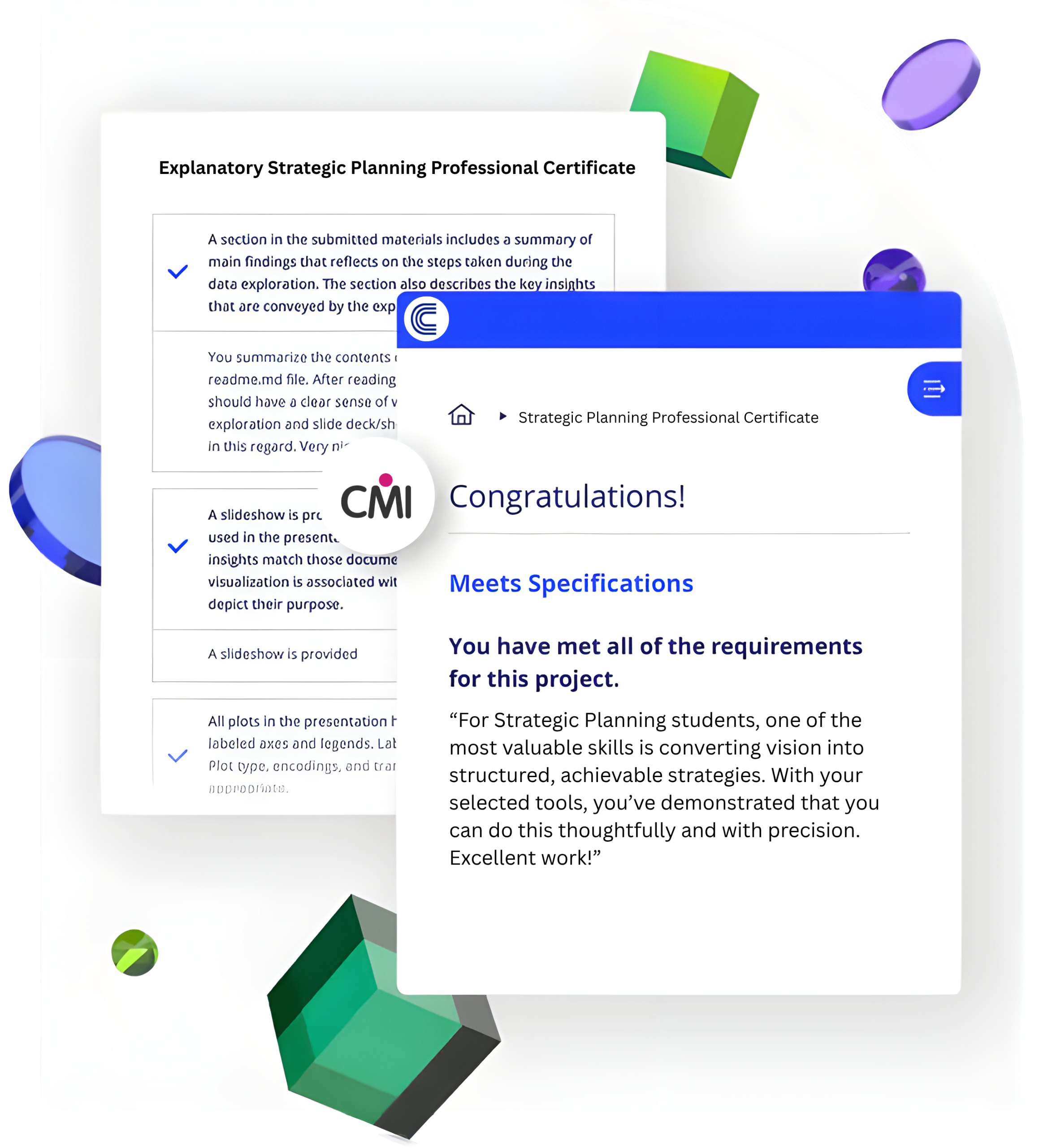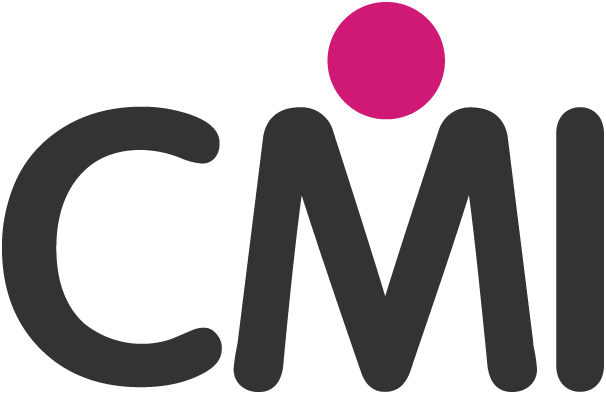- Subsidiary from The E Platform FZC, UAE.
- [email protected]
- +971-569-541-842
Categories
Professional Certificates
Strategic Planning Professional Certificate
Master the skills to analyze business environments, set long-term goals, and implement strategic plans that drive sustainable growth and organizational success.
4.5 (59 Rating)
Duration:
15س
Enrolled: 75
- Program Language: Arabic and English
- Study Method: Self-study with personalized follow-up sessions from our experts
- Access Duration: 3 Months
- Level: Mid to Senior-Level Professionals
- Certification: CMI Certificate
Why Earn a CMI-Accredited Strategic Planning Professional Certificate?
- Advanced Strategic Expertise: Acquire specialized skills to analyze business environments, strategically set goals, and lead successful strategy implementation.
- Proven Career & Revenue Impact: Certified professionals contribute directly to long-term organizational success, with 74% achieving measurable revenue growth.
- Integrated MBA Advantage: This certificate program fulfills 10% of the MBA curriculum, offering a foundation for advanced professional development for any aspiring strategic planning professional.
- Exclusive Resource Access: Receive one year of free access to ManagementDirect, which includes strategic frameworks, case studies, and planning tools used by top business school programs.
- Flexible & Supported Learning Path: Designed for strategic planning professionals, this program offers flexible self-study and one-on-one expert support.

Learning Outcomes
Strategic analysis
Book A Session and Improve your skills!
Long-term planning
Book A Session and Improve your skills!
Goal setting
Book A Session and Improve your skills!
Resource allocation
Book A Session and Improve your skills!
Strategic decision-making
Book A Session and Improve your skills!
Performance measurement
Book A Session and Improve your skills!
Strategic implementation
Book A Session and Improve your skills!
Change management
Book A Session and Improve your skills!
Risk management
Book A Session and Improve your skills!
Stakeholder communication
Book A Session and Improve your skills!
Course Curriculum
Unit1: Strategic Management Foundations | From Theories to Practical Approaches.
Understand the core principles of strategic planning and its role in shaping a business's future. Learn how mission, vision, and objectives align with broader business planning strategies to achieve organizational success.
-
Planning course Introduction – Video
-
Unit outro – Video
-
Unit Introduction – Video
-
Lesson 1: Mission, Vision, & strategies – Index
-
Lesson 1: What is Strategy?
-
Lesson 1: 5 Statements Misconception
-
Lesson 1: Vision
-
Lesson 1: Mision
-
Lesson 2: Objectives & Goals – Index
-
Lesson 2: Goals Definition
-
Lesson 2: Objectives Definition
-
Lesson 2: Goals &Objectives examples
-
Lesson 2: SMART acronym
-
Lesson 2: The 7 Steps to Setting S.M.A.R.T.E.R. Goals
-
Lesson 1 & 2: Quiz
-
Lesson 3: Strategies & Tactics – Index
-
Lesson 3: Strategies definition
-
Lesson 3: Example strategic options
-
Lesson 3: Tactics definition
-
Lesson 3: objectives,goals,target,strategies &tactics – Video
-
Lesson 4: Strategic Planning – Index
-
Lesson 4: What is a strategic plan?
-
Lesson 4: The Central Role of Strategic Planning
-
Lesson 4: Four organizational levels
-
Lesson 4: Business Plan
-
Lesson 4: Build a Culture That Aligns with People’s Values – Further readings
-
Lesson 4: Strategic Plans v.s Business Plans – video
-
Lesson 4: Examples on Strategic Planning – Video
-
Lesson 3 & 4: Quiz
-
Lesson 5: Core Organizational Values – Index
-
Lesson 5: Core Organizational Value – Overview
-
Lesson 5: Four core values for every organisation
-
Lesson 5: Build a Culture That Aligns with People’s Values – Further readings
-
Lesson 5: Quiz
-
Lesson 6: Strategic Diversity Management – Index
-
Lesson 6: What is Diversity?
-
Lesson 6: What is Inclusion?
-
Lesson 6: Driving Diversity And Inclusion In The Workplace – Further readings
-
Lesson 6: The impact of diversity and inclusion
-
Lesson 6: Diversity and inclusion in the workplace: Benefits and challenges – Further readings
-
Lesson 6: Diversity strategies
-
Lesson 6: Diversity in the Times of COVID-19: Why It Matters More? – Further readings
-
Lesson 6: Business growth
-
Lesson 6 : Choosing the right business growth capital
-
Lesson 6 : 7 Strategies to Grow Your Business | Brian Tracy – Video
-
Lesson 6 : Why is culture diversity is important ? – Video
-
Lesson 7: Profit Market share – Index
-
Lesson 7 : Market share – Overview
-
Lesson 7 : Benefits of Market Share
-
Lesson 7 : Market Share Impact
-
Lesson 7 : How Can Companies Increase Market Share?
-
Lesson 7 : Apple Case study
-
Lesson 7 : Market Share Importance
-
Lesson 7 : What Strategies Are Used to Gain Market Share?
-
Lesson 7 : Profit Market Share – Video
-
Final Exam Unit 1
Unit 2: Strategic Analysis Methodologies
Develop the ability to analyze external and internal business environments using proven strategic analysis tools. Learn how to conduct macro and micro environmental scanning to gain insights into market trends and competitors.
-
Unit Objectives
-
Unit Introduction – Video
-
Lesson 1: Phases of Strategic Management – Index
-
Lesson 1: Phases of Strategic Management – Overview
-
Lesson 1: Four Phases of Strategic Management
-
Lesson 1: Case Studies
-
Lesson 1: Levels of Strategies with Persons Most Resposible
-
Lesson 1: Quiz
-
Lesson 2: Macro Environmental scanning – Index -Part One
-
Lesson 2: Environmental scanning
-
Lesson 2: How Macro Environmental scanning affect the marketing strategy and when to use each tools
-
Lesson 2: Macro Environment Factors
-
Lesson 2: Social and cultural forces
-
Lesson 2: SWOT Analysis
-
Lesson 2: SWOT analysis example
-
Lesson 2: PESTLE
-
Lesson 2: PESTEL analysis – Further Readings
-
Lesson 2: Porter 5 forces
-
Lesson 2: Porter 5 forces – Threat of New Entrants
-
Lesson 2: Porter 5 forces – Rivalry among Existing Firms
-
Lesson 2: Porter 5 forces – Threat of Substitute Products or Services
-
Lesson 2: Porter 5 forces – The Bargaining Power of Buyers
-
Lesson 2: Porter 5 forces – The Bargaining Power of Suppliers
-
Lesson 2: The Relative Power of Other Stakeholders
-
Lesson 2: competitive-analysis-frameworks- Further readings
-
Porter’s Five Forces – Video
-
Lesson 2: Macro Environmental scanning – Index -Part Two
-
lesson 2: Ansoff Matrix
-
Lesson 2: Ansoff Matrix -Market penetration
-
Lesson 2: Ansoff Matrix -Market Development
-
Lesson2: Ansoff Matrix -Product Development
-
Lesson2: Ansoff Matrix -Diversification
-
Lesson2: ANSOFF Matrix – Further readings
-
Lesson 2: Quiz
-
Lesson 3: Micro Environmental scanning – Index
-
Lesson 3: How to make Market research ? – Video
-
Lesson 3: Micro Environment definition
-
Lesson 3: Micro Environment Factors
-
Lesson 3: Market Research definition
-
Lesson 3: Market research importance
-
Lesson 3: Types of Market Research
-
Lesson 3: Primary Market Research
-
Lesson 3: Secondary research
-
Lesson 3: Steps for conducting Market Research
-
Lesson 3: Step #1: Define the Problem
-
Lesson 3: Step #2: Define the Sample
-
Lesson 3: Step #3: Carry out data collection
-
Lesson 3: Step #4: Analyze the results
-
lesson 3: How can researchers measure the obtained results?
-
Lesson 3: Step #5: Make the Research Report
-
Lesson 3: Step #6: Make Decisions
-
Lesson 3: Benefits of Efficient Market Research
-
Lesson 3: Primary vs. Secondary Data – Further Readings
-
Lesson 3 : Quiz 🧮
-
Lesson 4: Tools Of Analysis – index
-
Lesson 4: Tools of Analysis – Overview
-
Lesson 4: Explanation with examples of Porter’s Value chain analysis in marketing – Video
-
Lesson 4: Porter’s Value Chain Analysis
-
Lesson 4: The firm’s primary activities
-
Lesson 4: How to Improve the Value Chain ?
-
Lesson 4: Market Share Analysis
-
Lesson 4: Market share analysis activites
-
Lesson 4: marketshare – Furether Readings
-
Lesson 4: Internal Surveys & Statistical
-
Lesson 4: The Theoretical Foundations of Employee Survey Research
-
Lesson 4: Employee survey research
-
Lesson 4: managing employee surveys – Further Readings
-
Lesson 4: TWOS Analysis
-
Lesson 4: Explanation with examples of BCG analysis in marketing – Video
-
Lesson 4: BCG analysis
-
Lesson 4: The Use of the Growth-Share Matrix in Strategic Planning – Further Readings
-
Lesson 4: Life Cycle Analysis
-
Lesson 4: Life Cycle Analysis- 4 stages
-
Lesson 4: Resources analysis
-
Lesson 4: In-depth Resource Analysis with VRIO
-
Lesson 4: Definition of objectives and the scope of study
-
Lesson 4: Resources analysis – Video
-
Lesson 4: Strategic management 3 Resource analysis, competences – Further Readings
-
Final exam
Unit 3:Business Planning for Organizational Growth.
Explore different organizational strategies and their application in achieving long-term business goals. Learn about corporate strategies, strategic plan audits, and stakeholder engagement.
-
Unit Introduction : Organizational Strategy Introduction -Video
-
Unit Objectives
-
Lesson 1: Levels of Strategy – Index
-
Lesson 1: Organisational strategy Definition
-
Lesson 1: Levels of Strategic Management – Video
-
Lesson 1: Organisational strategy Levels.
-
Lesson 1: Why Does Your Business Need An Organisational Strategy?.
-
Lesson 1: Key Features of an Organisational Strategy
-
Lesson 1: Guideline for effective strategic management
-
Lesson 1: Joseph Charyk
-
Lesson 1: Quiz
-
Lesson 2: Strategic Plans – Index
-
Lesson 2: Ansoff Matrix
-
Lesson 2: Ansoff Matrix -Market penetration
-
Lesson 2: Ansoff Matrix -Market Development
-
Lesson 2: Ansoff Matrix -Product Development
-
Lesson 2: Ansoff Matrix -Diversification
-
Lesson 2: Porter’s Generic Competitive Strategies
-
Lesson 2: Porter’s Generic Competitive Strategies -Differentiation
-
Lesson 2: Porter’s Generic Competitive Strategies -Cost Leadership
-
Lesson 2: Porter’s Generic Competitive Strategies -Focus
-
Lesson 2: Explanation with examples of Porter’s competitive advantages – Video
-
Lesson 2: Mintzberg’s strategies
-
Lesson 2: Porter generic strategiess the fall and rise of strategic planning – Further readings
-
Lesson 2: Mintzberg 5Ps for Strategy PDF – Further readings
-
Lesson 2 : Quiz 🧮
-
Lesson 3: Corporate Strategy – Part One – Index
-
Lesson 3: Corporate strategy
-
Lesson 3: Diffrenciations between corporate strategies types – Video
-
lesson 3: Why is corporate strategy important?
-
Lesson 3: Corporate-level strategy
-
Lesson 3: Corporate Strategy – Part two – Index
-
Lesson 3: Types of Corporate Strategies
-
Lesson 3: Stability Strategy
-
Lesson 3: Expansion Strategy (Growth Strategy)
-
Lesson 3: Diversification
-
Lesson 3: Best examples of business diversification strategy
-
Lesson 3: When Diversification goes wrong
-
Lesson 3: Retrenchment Strategies (defensive strategy)
-
lesson 3: Combination Strategy
-
Lesson 3: Combination Strategy case study – Amazon Prime
-
Lesson 3: Strategic Alliance
-
Lesson 3: 10 Strategic Alliance Examples From Top Brands – Further readings
-
Lesson 3: Strategic Marketing
-
Lesson 3: Strategic Marketing – Video
-
Lesson 3: Strategies for High Market-Share Companies – Further readings
-
Lesson 3: Merger Strategy
-
Lesson 3: How Mergers Are Structured
-
Lesson 3: How Acquisitions Are Financed
-
Lesson 3: Why Do Companies Keep Acquiring Other Companies Through M&A?
-
Lesson 3: Restructure Strategy
-
Lesson 3: Restructure Strategy – Reasons for Corporate Restructuring
-
Lesson 3: Restructure Strategy – Valuation Services For Corporate Restructuring
-
Lesson 3: Quiz
-
Lesson 4: The company wants to exploit potential synergies – Index
-
Lesson 4: Testing & Analyzing the Strategic Plans
-
Lesson 4: Strategic contingencies theory – Further readings
-
Lesson 4: Tools of analysis used to test the efficiency of a strategic Plan
-
Lesson 4: Tools used in Gap Analysis
-
Lesson 4: How to create cause-and-effect diagrams – Video
-
Lesson 4: PART 6 OF 7: Nadler-Tushman’s Congruence Model – Video
-
Lesson 4: benchmarking Analysis
-
Lesson 4: Benchmarking Marketing Capabilities for Sustainable Competitive Advantage – Further readings
-
Lesson 4: Profitability
-
Lesson 4: What is the Portfolio Analysis? – Further readings
-
Lesson 4: Profitability Ratios | A-Level, IB & BTEC Business – Video
-
Lesson 4: Portfolio
-
Lesson 4: Feasability studies
-
Lesson 4: What Is a Feasibility Study? How to Conduct One for Your Project – Further readings
-
Lesson 4: Risk Assessment
-
Lesson 4: When to use each tools of analysis? – Video
-
Lesson 4 : Quiz
-
Lesson 5: When to use each tools of analysis? – Index
-
Lesson 5: The Business Plan
-
Lesson 5: Traditional business plans
-
Lesson 6: The Stakeholders – Index
-
Lesson 6: Stakeholders
-
Lesson 6: How do we engage stakeholders?
-
Lesson 6: Strategic Management of Stakeholders: Theory and Practice – Further readings
-
Lesson 6: Why Stake holders matters ? – Video
-
Final exam
-
Unit outro.
Strategic planning Assignments.
-
Task 1
-
Task 2
-
Task 3
-
Task 4
-
Task 5
Live sessions
-
test 1
Frequently Asked Questions.
This program helps professionals develop the mindset and tools needed to become a confident strategic planning professional, make strategic decisions, and adapt to dynamic business environments with clarity and impact.
Ideal for managers, team leads, and analysts involved in business planning, operations, or strategy. It’s also a great fit for professionals seeking professional development in long-term thinking and strategy planning.
Unlike general online courses, this certificate program focuses specifically on practical frameworks, stakeholder alignment, and real-world strategy implementation, perfect for future strategic management professionals.
Absolutely. You’ll walk away with actionable tools and templates you can use to plan and execute strategies, evaluate plans, and align teams, immediately applicable across industries.
Testimonials
"The Strategic Planning Certificate gave me the tools to analyze market trends and make strategic business decisions with confidence."
Ahmed Al-Farsi
“A must-have certification for any strategic planning professional looking to refine their planning and strategy execution skills.”
Fatima Al-Hassan
"This program helped me align business objectives with actionable strategies, making a direct impact on my career growth."
Khalid Al-Naimi
Elevate Your Career




